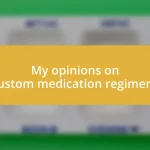Key takeaways:
- Understanding gene therapy offers hope for curing genetic disorders by replacing faulty genes with healthy ones, utilizing methods like CRISPR and viral delivery.
- Preparing for gene therapy involves gathering medical history, establishing a support system, and focusing on mental readiness to handle the emotional impact of treatment.
- Managing expectations during treatment is crucial, as healing is non-linear; sharing experiences with others and maintaining a daily routine can aid emotional resilience and recovery.

Understanding Gene Therapy Basics
Gene therapy is like a repair kit for our DNA, the blueprint of life. Imagine if a mechanic could swap out a faulty part in your car – that’s essentially what gene therapy does at the cellular level. When I first learned this, I was fascinated by the idea that we could potentially fix genetic disorders by simply altering our genes.
I remember sitting in a seminar, listening to a doctor passionately explain how gene therapy can replace faulty genes with healthy ones. It struck me how revolutionary this could be for conditions like cystic fibrosis or hemophilia. Have you ever thought about how much hope this brings to patients and their families? It felt like a light bulb moment, realizing that this technology could change lives, including those of children who had been battling these diseases for years.
What really hit home for me was understanding the different methods of gene delivery. Whether it’s using a harmless virus as a delivery vehicle or employing techniques like CRISPR for precise editing, the complexity and potential are astounding. I often found myself pondering how such advancements could pave the way for cures yet to be imagined. In this evolving landscape, I can’t help but feel excited—and a bit nervous—about the future of medicine.

Preparing for Gene Therapy
Preparing for gene therapy was both exciting and daunting. As I delved into the necessary preparations, I reflected a lot on my own health journey. Understanding my medical history and genetic background became crucial, as it paved the way for discussions with my healthcare team. Have you ever had to collect all your health records? It felt like piecing together a puzzle, but I knew it would be worth it in the end.
Deciding to include supportive friends and family made my preparation more manageable. Sharing my fears and uncertainties with them was liberating. I found that having a solid support system helped me feel less alone. In fact, I remember my sister researching gene therapy while comforting me late at night, transforming my anxious thoughts into conversations filled with hope and reassurance.
I also discovered the importance of preparing mentally and emotionally. It wasn’t just about the medical protocol; it was about processing the changes that were about to happen in my life. Journaling became my outlet as I wrote about my feelings and anticipations. Looking back now, I realize how essential that reflection was in embracing this groundbreaking treatment.
| Preparation Aspect | My Experience |
|---|---|
| Medical History Review | Gathered all records, felt insightful but overwhelming. |
| Support System | Involving family and friends eased my fears and brought comfort. |
| Mental Readiness | Journaling helped process emotions and anticipate changes. |

Choosing the Right Specialist
Choosing the right specialist for gene therapy felt like a significant crossroads in my journey. I quickly realized that not all healthcare professionals have the same expertise in this rapidly evolving field. I remember feeling overwhelmed by the choices, but then I set some criteria to help narrow my search.
Here are a few key factors I considered when choosing my specialist:
– Experience in Gene Therapy: I looked for doctors with a proven track record in gene therapy, ideally those published in reputable journals or involved in clinical trials.
– Patient Reviews: Online forums and testimonials offered insights into others’ experiences, making me feel more connected to the community.
– Accessibility: I sought out specialists who were easy to reach, ensuring that I wouldn’t be left in the dark during critical moments.
– Collaborative Approach: Finding someone who listened and involved me in decision-making was essential; after all, it was my health journey.
Navigating this process taught me the importance of feeling comfortable and understood by my specialist. I can vividly recall my first consultation. The way the doctor explained complex concepts in relatable terms not only calmed my nerves but also made me feel valued as a patient. It reinforced my belief that a good specialist isn’t just knowledgeable; they should also possess the empathy to guide you through such a life-changing experience.

Navigating Treatment Options
Navigating treatment options for gene therapy can feel like wandering through a maze. When I first began exploring my choices, I was emotionally charged, alternating between excitement and anxiety. It was essential for me to thoroughly research the various therapies available and their potential risks and benefits. Have you ever felt that overwhelming sense of possibility, only to be met with an avalanche of information? I certainly did, but breaking each option down into manageable parts made it more approachable.
One pivotal moment for me was attending informational sessions hosted by clinical centers. Hearing firsthand accounts from patients who had already undergone treatment added a personal touch that books and articles simply couldn’t provide. I remember one veteran patient saying, “You have to weigh your options, but trust your gut.” Those words stuck with me and encouraged me to listen to my instincts as I sifted through the available treatments, ultimately leading me towards the choice that felt right for me.
Equally important was having candid discussions with my healthcare team. They encouraged me to ask questions—lots of them. I found this dialogue critical, as it illuminated paths I hadn’t previously considered. Each conversation revealed new insights and helped to clarify my thoughts. Reflecting on that experience, I now appreciate how open communication is essential. It is not just about getting answers; it’s about ensuring that my treatment journey aligns with my values and life goals. How empowering is it to be an active participant in your own healthcare journey? For me, it felt like taking control at a time when everything else seemed uncertain.

Managing Expectations During Treatment
Managing expectations during gene therapy treatment is crucial for emotional resilience. I vividly recall the initial days after starting my therapy; my mind was flooded with hopes and fears. Would I feel better right away? Would it actually work? I learned that tempering my enthusiasm with realism helped me stay grounded. This treatment is not a magic bullet; it’s a process, and understanding that made a world of difference.
I often visualized my progress as climbing a staircase—sometimes, I’d have two steps forward, but there were moments when it felt like I was stumbling back. Talking to other patients who were further along in their journey was invaluable. Their stories provided perspective on what to expect, reminding me that healing is rarely linear. Have you ever felt encouraged just by hearing someone else’s experience? It’s fascinating how shared narratives can offer comfort and guidance.
One lesson that resonated with me was embracing uncertainty. I remember sitting in my treatment room, watching the IV drip, and feeling a mix of anticipation and trepidation. I realized that learning to accept the unknown could alleviate some anxiety. Establishing a support network of family and friends who I could share my ups and downs with helped tremendously. Ultimately, it’s about finding joy in the small milestones and having patience with the journey—something I repeat to myself often.

Coping with Side Effects
Coping with side effects can feel overwhelming and isolating. I remember the first few days after my gene therapy when fatigue swept over me like a heavy blanket. I found myself in bed, scrolling through countless forums. Everyone had different experiences, which only compounded my anxiety. It prompted me to ponder: How could I better prepare myself emotionally and physically for these changes? Realizing that I was not alone in feeling this way was a crucial step in my journey.
One of the most effective strategies I discovered was to establish a daily routine that accounted for the unpredictability of my symptoms. I made it a point to integrate light exercises, such as stretching, into my mornings. These gentle movements not only helped alleviate some discomfort but also lifted my spirits. Have you ever noticed how even just stepping outside for fresh air can sometimes shift your perspective? I learned to cherish those small moments, as they served as reminders that I was still engaging with life, despite the side effects.
I also leaned heavily on journaling. Writing down my feelings became a release, a way to process everything swirling in my mind. After a particularly tough day, I penned, “I may not feel like myself right now, but I’m still here, and that counts.” This simple affirmation became my mantra. Sharing my writings with supportive friends opened up conversations about our collective experiences, proving that vulnerability fosters connection. Have you ever tried writing out your challenges? It’s astonishing how much clarity it can bring when you give your emotions a voice.

Reflecting on the Experience
Reflecting on my experience with gene therapy, I often find myself revisiting those initial moments of uncertainty. I vividly recall sitting in the clinic, my heart racing as I waited for the treatment to begin. It was a bizarre mix of hope and dread—did I really have the courage to embark on this journey? I learned that acknowledging these conflicting emotions was essential; it allowed me to process my fears rather than push them aside.
As the days turned into weeks, I was surprised by how pivotal my emotional state became in my recovery. Each time I experienced a slight improvement, I felt a rush of elation, but setbacks would send me spiraling into doubt. I remember one particular day when I felt renewed energy only to be hit hard by sudden fatigue the next day. Would I ever find a balance? In retrospect, I came to understand that these fluctuations mirrored the ups and downs of life itself and that accepting this ebb and flow was a critical part of the healing process.
Navigating this experience taught me the profound impact of community. I found solace in connecting with others who were on similar paths; sharing our stories fostered a unique bond. I remember one discussion that stemmed from a casual chat about our favorite recovery meals, which quickly turned into a heartfelt exchange about our fears and triumphs. Isn’t it remarkable how shared experiences can lift our spirits? Those conversations were pivotal, reminding me I was never truly alone in this journey.














